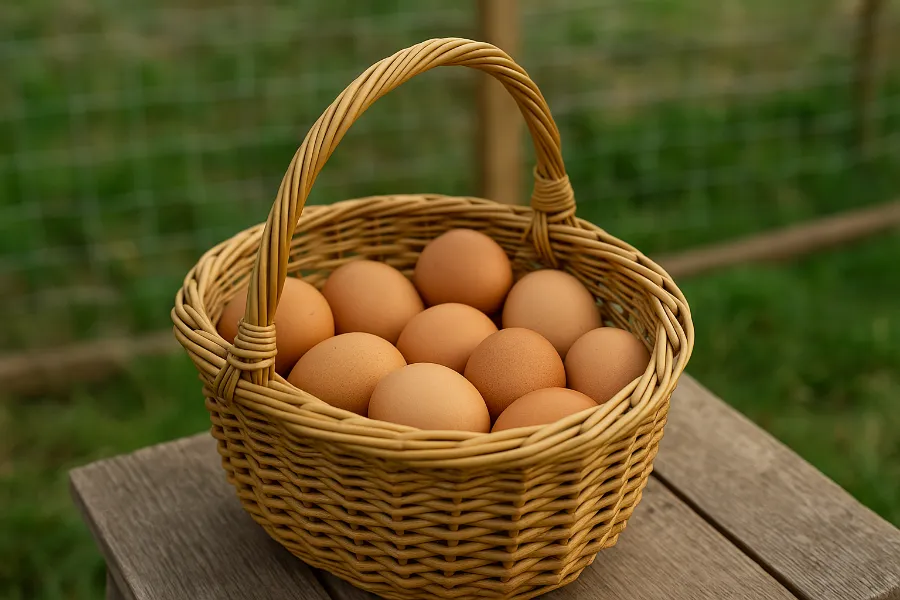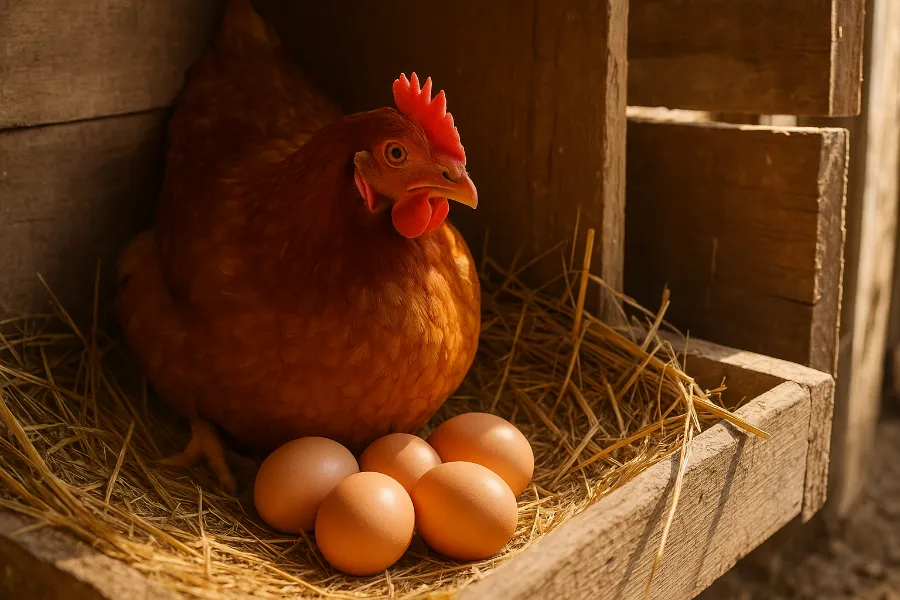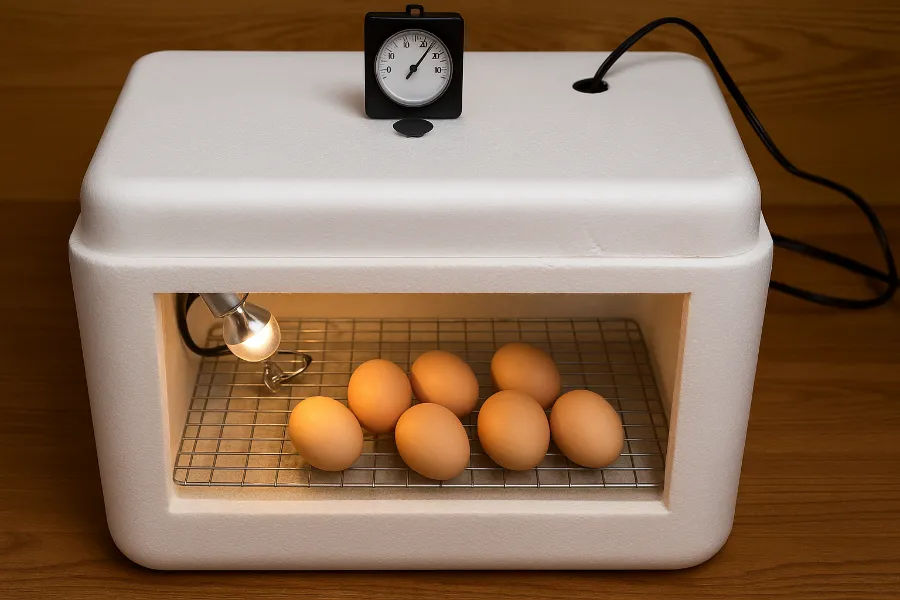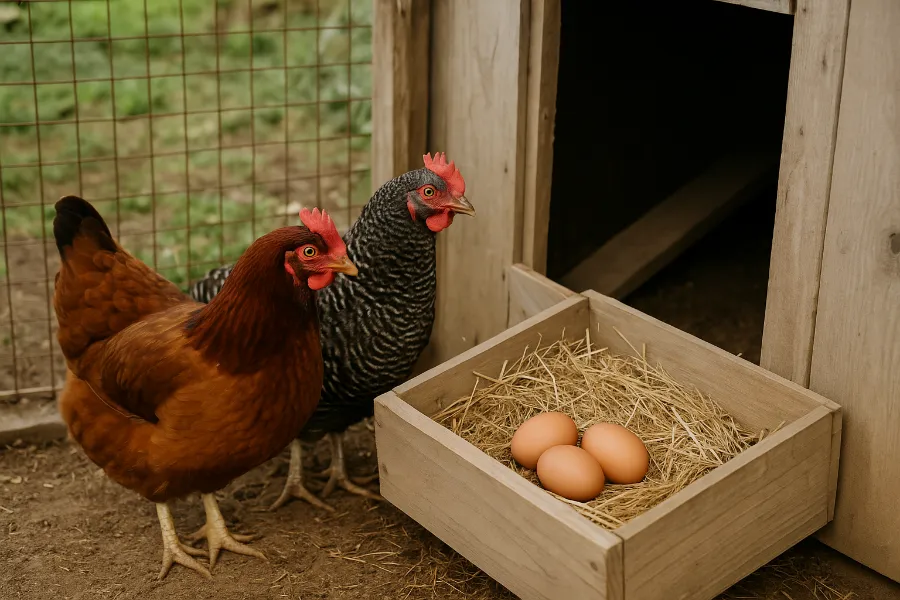When I first started keeping chickens, I didn’t think twice about what was happening inside an egg. But one spring morning, as I cracked open a warm brown egg straight from the nest, I noticed a tiny white dot on the yolk. That’s when I learned the fascinating truth about fertilized vs unfertilized eggs — and how much those two little words can reveal about your flock, your rooster, and even your breakfast.
This post breaks down everything I’ve learned through years of backyard chicken keeping — how to tell if an egg is fertile, whether you can eat fertilized eggs, what role a rooster really plays, and how all of this ties into raising a happy, productive flock.
Let’s crack this open, shall we?

Fertilized vs Unfertilized Chicken Eggs
Both types of eggs start the same way — formed inside a hen’s body, wrapped in layers of calcium, and laid with astonishing regularity.
The difference comes down to whether a rooster and hen have mated before the egg was laid.
- Unfertilized chicken eggs come from hens that haven’t been with a rooster. They’ll never develop into chicks, no matter how long you incubate them.
- Fertilized eggs, on the other hand, contain a single cell — a zygote — that can develop into a chick if it’s kept warm and humid for about 21 days.
From the outside, they look identical. You can’t tell which is which just by holding them. Both taste the same, cook the same, and store the same. The only difference is potential — one has the chance to become new life, and the other is destined for breakfast.
Fertilized Eggs
When hens live naturally with roosters, some of their eggs will be fertilized. It’s perfectly normal — and perfectly safe.
A fertilized egg doesn’t start developing until it’s exposed to consistent warmth (either from a broody hen or an incubator). As long as you collect eggs daily and refrigerate them, nothing inside changes.
I’ve eaten fertilized eggs for years. They have the same texture, the same flavor, and the same nutrition as unfertilized ones. The only difference is that beautiful connection between the flock and the cycle of life — something you feel deeply once you’ve seen a chick hatch from a shell.
Unfertilized Chicken Eggs
If you don’t have a rooster, all of your eggs will be unfertilized. Most backyard keepers prefer this setup — it’s quieter, simpler, and still gives you plenty of fresh eggs.
Unfertilized chicken eggs are what you buy in the grocery store. They come from hens who lay regularly without ever mating. You can collect them, wash them, store them, pickle them, or water-glass them for winter — they’ll never contain a chick.
In many ways, unfertilized eggs are the steady heartbeat of a flock — dependable, abundant, and completely edible.
Can You Eat Fertilized Chicken Eggs?

Yes, absolutely. I get this question more than any other, and it’s one of the biggest myths in chicken keeping.
You can eat fertilized chicken eggs just like any other. As long as they haven’t been incubated, they’ll be identical in flavor and texture. The fertilization process happens long before the shell forms, and without warmth, the embryo doesn’t develop.
For safety:
- Collect eggs daily (especially in summer).
- Store them at 40°F (4°C) or cooler.
- Avoid leaving them under a broody hen for long periods.
If your eggs are clean and fresh, they’re safe to scramble, fry, bake, or poach — no matter what kind of rooster-to-hen ratio you have.
How to Tell If Chicken Egg Is Fertile
Here’s the fun part — finding out what’s happening inside the shell.
When I first learned to check fertility, it felt like detective work. There are two main ways to tell if a chicken egg is fertile:
1. Crack Test (Germinal Disc)
Crack the egg open on a flat surface and look closely at the yolk.
- A tiny white dot means the egg is unfertilized.
- A bullseye pattern — a faint white ring with a lighter center — means the egg is fertilized.
That little bullseye is the germinal disc — the place where life begins if given the right warmth.
2. Egg Candling
Egg candling is an age-old homesteading trick. Hold an egg up to a bright light in a dark room. You can buy special candler lights, but a small flashlight works fine.
- Fertilized eggs that have been incubated for a few days will show a small dark spot with veins.
- Unfertilized eggs will appear clear inside.
Candling is magical — like watching life glow through the shell.
Do Chickens Need a Rooster to Lay Eggs?
This question comes up every time someone starts keeping hens: Do chickens need a rooster to lay eggs?
Nope! Hens are wonderfully self-sufficient. Their bodies are programmed to produce eggs regularly, rooster or not. The rooster’s only role is fertilization — not egg production.
So if you’re raising chickens for eggs and not chicks, you don’t need a rooster at all. You’ll still get fresh eggs nearly every day from a happy, healthy flock of hens.
Can Hens Lay Eggs Without a Rooster?
Yes — and they do it all the time.
A hen’s laying cycle is controlled by light, nutrition, and health, not by the presence of a rooster. Can hens lay eggs without a rooster? Of course! That’s how every egg in a grocery store is made.
The only difference is that unfertilized eggs can’t hatch. They’re perfect for eating, preserving, and selling. So if you’re worried about noise, aggression, or zoning rules that restrict roosters, rest easy — your hens will still keep those nesting boxes full.
Rooster and Hen Mating
If you do have a rooster, you’ll notice some interesting behavior. A rooster doesn’t just fertilize an egg once; his sperm can remain inside the hen’s reproductive tract for up to two weeks.
That means even after you separate him, the next dozen or so eggs might still be fertilized.
During rooster and hen mating, you’ll see quick, sometimes clumsy movements — it’s over in seconds. A healthy ratio is one rooster for every 8–10 hens. That keeps the peace and ensures good fertility without overbreeding.
Don’t worry if your rooster’s affection looks rough; minor feather loss on hens’ backs is normal. If it becomes excessive, hen saddles (protective aprons) can help.
Incubation Temperature for Chicken Eggs
If you’ve ever decided to hatch chicks — either under a hen or using a machine — temperature becomes everything.
The perfect incubation temperature for chicken eggs is 99.5°F (37.5°C).
Humidity should stay around 45–50% for the first 18 days, then rise to 60–65% for hatching.
Turn the eggs gently three to five times a day to prevent the embryo from sticking to the shell. Around day 18, stop turning and let the chicks settle into position for hatching.
By day 21, you’ll hear faint peeps and see tiny cracks forming. It’s one of the most rewarding moments in chicken keeping — new life from something you collected just three weeks ago.
Best Incubator for Chicken Eggs

I’ve used everything from DIY styrofoam boxes to digital incubators with temperature alarms.
When choosing the best incubator for chicken eggs, consider your goals:
Budget Option (Under $100)
- Manual temperature control
- Hand-turning eggs daily
- Great for beginners with small batches
Mid-Range ($150–$300)
- Digital display for temp/humidity
- Automatic turning
- Reliable for homestead hatching projects
High-End ($400+)
- Fully automated
- Precision controls for humidity and air flow
- Perfect for breeding programs or schools
For me, the middle range hits the sweet spot — reliable, easy to clean, and consistent results.
Fertilized Eggs for Sale
If you don’t have a rooster but want to experience hatching, you can find fertilized eggs for sale locally or online.
When buying:
- Choose reputable breeders who pack eggs properly.
- Ask about hatch rates and parent stock health.
- Avoid eggs older than 10 days.
I prefer sourcing locally to reduce shipping stress. Transported eggs can still hatch, but gentle handling and short travel times help tremendously.
Egg Candling
Egg candling isn’t just a way to check fertility — it’s also useful for freshness and development.
Here’s what you’ll see under the light:
- Fresh unfertilized egg: clear with a small air pocket.
- Developing fertilized egg: visible veins or a dark embryo spot.
- Old egg: large air cell, yolk floats upward.
Candling helps you track growth and remove any non-developing eggs before they spoil in the incubator.
Broody Hen
Every flock has that one hen who suddenly refuses to leave the nest — that’s your broody hen.
When her hormones kick in, she’ll pluck feathers from her chest, sit on eggs all day, and hiss when disturbed. She’s not being dramatic — she’s being maternal.
A broody hen can hatch fertilized eggs naturally. Just slip a clutch of 8–10 fresh eggs under her and let her do the rest. She’ll regulate temperature, humidity, and turning perfectly — no machine required.
If you want to raise chicks the natural way, a broody hen is worth her weight in gold.
Raising Chickens for Eggs
Whether your flock produces fertilized or unfertilized eggs, the joy of raising chickens for eggs never fades.
Every morning, I walk to the coop, open the nesting boxes, and feel the warmth of freshly laid eggs. It’s a simple pleasure that connects you to the rhythm of life and seasons.
Coop Tips for Healthy Layers
- Keep at least 4 sq. ft. of space per hen.
- Provide nesting boxes lined with clean straw.
- Use good ventilation — fresh air keeps stress (and fertility issues) down.
- Feed a balanced layer ration with added calcium for strong shells.
When your hens are comfortable, their eggs — fertilized or not — will always be top quality.
Fertilized vs Unfertilized Eggs: My Takeaway

After years of collecting eggs, watching chicks hatch, and learning from mistakes, here’s what I’ve come to believe:
- Fertilized eggs represent possibility the next generation, new life, and the heart of homesteading.
- Unfertilized eggs represent nourishment wholesome, simple, and steady.
Both deserve appreciation.
If you’re new to chicken keeping, don’t worry too much about which type you have. Focus on caring for your flock, providing good feed, and keeping the coop healthy. You’ll learn the differences naturally over time.
In the end, understanding fertilized vs unfertilized eggs isn’t just science it’s connection. It’s knowing your birds, respecting the life they create, and realizing that every egg, whether it becomes breakfast or a baby chick, is something truly extraordinary.
FAQs
Fertilized eggs come from hens that have mated with a rooster and can develop into chicks. Unfertilized eggs come from hens without roosters and will never hatch.
Yes, fertilized chicken eggs are completely safe to eat. They taste and look the same as unfertilized eggs if collected and refrigerated promptly.
No, hens will lay eggs whether or not a rooster is present. A rooster is only needed if you want fertilized eggs for hatching.
Look for a bullseye pattern on the yolk or use egg candling after a few days of incubation. Fertilized eggs will show early embryo signs under light.
Fertilized eggs should be stored for no more than 7–10 days in a cool, humid place. Longer storage lowers the hatch rate significantly.
The ideal incubation temperature for chicken eggs is 99.5°F (37.5°C). Keep humidity around 45–50% until the final days when it should increase slightly.
Yes, hens can lay eggs naturally without a rooster. Those eggs will always be unfertilized and are perfect for everyday eating and storage.













